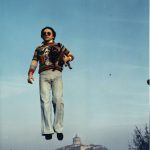
Universo Nespolo
Villa Giulia – Verbania
17-05-2025 | 28-09-2025
Anthological exhibition dedicated to Ugo Nespolo
The exhibition, curated by Sandro Parmiggiani and organized by the City of Verbania, presents a hundred works that retrace sixty years of the artist’s career, between experimentation, irony and constant innovation.
From painting to cinema, from photography to ceramics, from polychrome woods to artist’s books, Nespolo has always gone beyond the traditional boundaries of art, choosing to contaminate his language with unconventional fields.
His desire to bring art into life has translated into continuous research, which has involved collaborations with companies and entities outside the art system, in the belief that art must interact with everyday life.
The exhibition offers a series of rooms dedicated to the theme of numbers and logic, which many years later will give rise to works inspired by the golden section, large drawings on dusting paper, works in polychrome ceramics, those in inlaid polychrome wood and those in Murano glass, mostly made by the Barovier & Toso workshop.
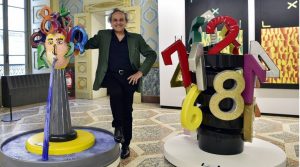
An entire room is then dedicated to the photographs that the artist took during his long stay in New York, in particular the shots linked to the areas south of Manhattan, where in the seventies and eighties a large number of the most important galleries in the world flourished.
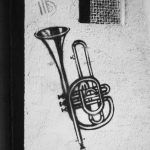
Also on display are models and sketches of the sets and costumes that Nespolo designed for the opera, for commissions from New York, Paris, Rome and beyond.
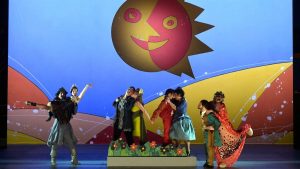
To complete the itinerary, some rare editions of artist’s books, a room dedicated to the most recent works of the Dark Side series, large-scale works with a fragmented narrative, and the large inflatable sculpture Ubu, positioned on the terrace of Villa Giulia and a symbol of optimism that, in a proactive and courageous way, accompanies, even in the often disturbing questions of today, the role of the artist and his practice.
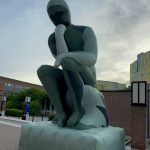
Three works by Nespolo will also be exhibited at the Museo del Paesaggio (Via Ruga 44 -Verbania), a cultural institution deeply linked to the territory of Lake Maggiore and its valleys.
A catalogue by Moebius Edizioni accompanies the exhibition.
Media partner: Sky arte.
A journey between poor art and Pop art
The anthology develops through an itinerary that crosses the main phases of Nespolo’s production, from the influences of the historical avant-gardes to the most recent experiments. The path begins in the Sixties, when the artist confronts Futurism and Dadaism before approaching Pop Art and Arte Povera. Precisely towards the latter, at the end of the decade, Nespolo takes a critical position, developing the Fogginia cycle: works made with precious materials such as ebony, silver and alabaster.
The artist’s inexhaustible experimental drive is reflected in the rooms dedicated to numbers and logic, themes that over the years will lead him to work on the golden section, on large drawings on dusting paper and on works in ceramics and inlaid polychrome wood. There is also a section dedicated to Murano glass creations, made in collaboration with the historic workshop Barovier & Toso.
New York, Opera and experimentation
An entire room hosts photographs taken by Nespolo in New York, where he stayed for a long time. The images document in particular the areas south of Manhattan, the heart of the art scene between the 1970s and 1980s, when avant-garde galleries transformed the neighborhood into a hub for contemporary art. The exhibition also dedicates space to the artist’s scenographic production, with sketches and models of sets and costumes created for the opera theater on commission from institutions of international importance, from New York to Paris, from Rome to other cities.
The exhibition itinerary is completed with a selection of rare artist books and a room entirely dedicated to the Dark Side series, composed of large canvases characterized by a fragmented narrative. To crown the exhibition project, the inflatable sculpture Ubu stands out on the terrace of Villa Giulia, a symbol of the optimism and ironic attitude with which Nespolo faces the challenges of the present. The exhibition also extends to the Museo del Paesaggio in Verbania, where three works by Nespolo will be exhibited. The institution, which has always been linked to the enhancement of the Lake Maggiore area, is thus part of the cultural and artistic promotion project that accompanies Universo Nespolo. A catalogue edited by Moebius Edizioni will accompany the exhibition. The official media partner of the event is Sky Arte, which will follow the exhibition with in-depth analysis and dedicated content.
Notes on the artist
Ugo Nespolo was born in Mosso and trained at the Albertina Academy of Fine Arts in Turin, later graduating in Modern Literature. In the 1960s he entered the Schwarz Gallery in Milan, alongside artists such as Duchamp and Picabia.
His first exhibition, Macchine e Oggetti Condizionali, curated by Pierre Restany, is part of the research that Germano Celant would define as “Arte Povera”.
Having moved to New York, he absorbed the cosmopolitan energy of the city and the charm of Pop Art, while in the Seventies he approached conceptual and poverty art. In 1967, thanks to the meeting with Jonas Mekas and Andy Warhol, he became one of the pioneers of Italian experimental cinema, collaborating with Mario Schifano and involving artists such as Baj, Pistoletto and Fontana.
Among his works, Revolving Doors, inspired by a text given to him by Man Ray. His films are screened in prestigious venues such as the Centre Pompidou and the Tate Modern.
With Enrico Baj he founded the Istituto Patafisico Ticinese and, with Ben Vautier, organized Fluxus concerts, including Les Mots et les Choses, the movement’s first Italian event.
Although fascinated by the American avant-garde, he maintains a strong bond with European art, drawing inspiration from Fortunato Depero and Futurism, with which he shares the idea of an art that permeates every aspect of life. From here comes his interest in design, advertising graphics, illustration and theatrical scenography.
Experimentation with materials is central to his path, leading him to work with wood, metal, glass, ceramics and fabrics.
Convinced that the artist must be an intellectual, he combines artistic practice with intense theoretical and writing activity. In 2019, the University of Turin awarded him an Honorary Degree in Philosophy. His work reflects on the nature of art itself: the object, extrapolated from its everyday context, takes on a new identity and value.


